|
Monday, July 5, 2010
Progress Notes
In a previous Progress Notes I featured some of the most appreciated school teachers in Miller County of the earlier years of its history. These included T.E. Vaughan, well known superintendent of the Eldon School system who was instrumental in starting its high school; T. C. Wright, the very well known and liked educator of the Tuscumbia school systems; C.D. Snodgrass, who greatly improved the quality of education in the country one room schools around the county; Cynthia Hawkins, the bilateral upper extremity amputee, who was elected county school commissioner in 1895, the first woman ever to hold public office in Miller County (at a time when women weren’t even allowed to vote!!) and who was selected for the role of “Pioneer School Teacher” in 1937 at the Miller County Centennial celebration pageant; and G. Byron Smith, the dynamic individual who was responsible for establishing the Iberia Academy. You can read the details of the stories of these individuals at the previous Progress Notes of June 30, 2008.
This week I want to add to the list of the most respected and well liked Miller County teachers the story of Eula Bilyeu Fischer (photo 01).
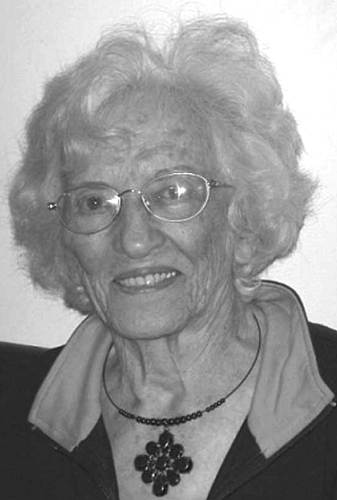
01 Eula Fischer The first resource I selected for telling the story of Eula was her granddaughter, Jamie Fischer Patterson of Tuscumbia (photo 02).

02 Jamie Fischer Patterson Eula Bilyeu Fischer
A Biography by Jamie (Fischer) Patterson
Quite often, while grocery shopping or running errands, someone stops me and says, “Are you Eula Fischer’s granddaughter? I used to go to school to her.” This common occurrence tends to leave me feeling uncommonly proud of my grandmother, who has lived to see 96 and ½ years of prolific and dynamic life, the whole of which I can barely sum up in a few paragraphs. Possessing a strength exemplified by many women living life in isolated rural areas over the past century, Eula made a comfortable home, raised a family, and lived as a farmer’s wife, often working hard to keep children and large groups of farm hands fed as needed. While fulfilling her domestic role, my grandmother added to her accomplishments by completing an advanced education in an era during which few women did so, working full-time in a long and significant career, and actively supporting her local community. I’m honored to give an account of her life as she has related it to me over the years.
Eula Bilyeu was born September 4, 1913, the first child of Clyde Bilyeu and LouAddie (Keeth) Bilyeu, both teachers in Miller County one-room schools (photo 03).
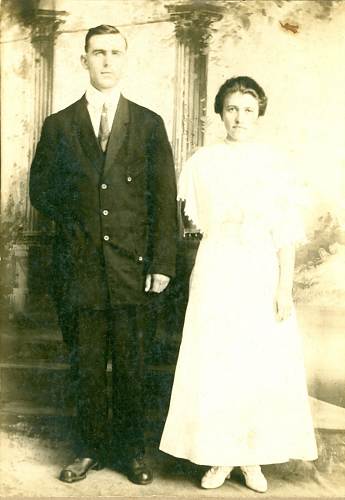
03 Lewis Clyde Bilyeu and LouAdie (Keeth) Bilyeu - July 12, 1912 Following her came three sisters and one brother: Cleeta, Fay, Norman, and Nina (photo 04).
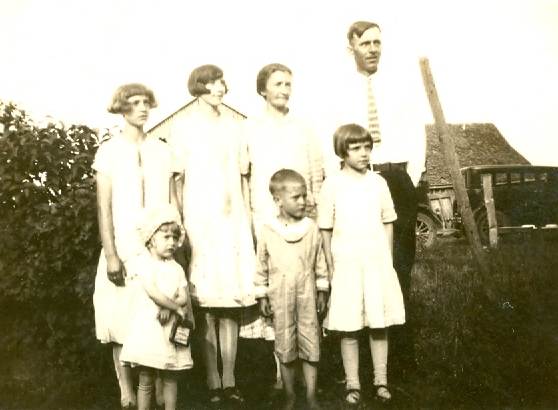
04 Cleeta, Eula, Addie, Clyde, Nina, Norman and Fay They lived near Iberia down what is now Brushy Fork Road, near the old Mount View church. Grandma’s memories of her childhood are typical of the era – riding horseback to school with her father, long and bumpy wagon rides to visit family, being sent to the creek to fetch milk and other perishables stored there. The Bilyeu’s were a musical family; my grandmother has often told me of her father’s remarkable ability to play any instrument by ear. She remembers her mother playing the piano as well and the sound of music being commonplace in the household.
Education was important to this family of teachers; when Eula completed the 8th grade, she moved on to the Iberia Academy in 1928, where she studied a classical curriculum that included Latin and Greek. Tragically, when Eula was just sixteen, her mother Addie passed away, a defining event that left Clyde a single father of several young children. Now juggling coursework and added duties at home, Eula still completed her high school education at the Academy, graduating with honors.
I often asked my grandma how she met my grandpa Bryce; she always laughs and tells me how she was walking with a friend and a brash young man pulled up in a buggy and said, “You girls need a ride?” I suppose it was “all downhill” from there. Eula Bilyeu married Bryce Fischer, son of John Nicholaus Fischer and Nellie (Sooter) Fischer Wiles of Ulman on June 12, 1932, in the midst of the Great Depression as Grandma is quick to remind me. And thus began her married life in the two-story white house on the farm in central Miller County between Tuscumbia, St. Elizabeth, and Iberia, where she lives still yet today (photo 05).
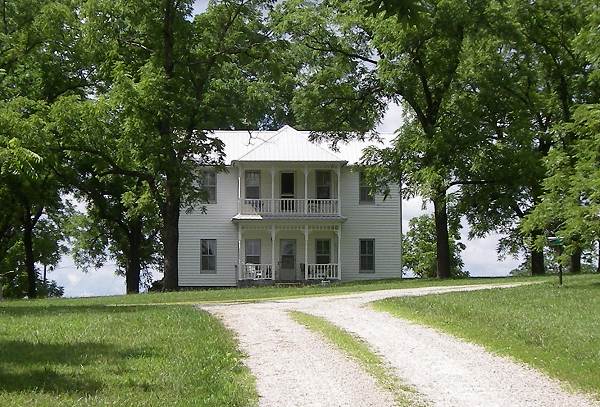
05 Eula Bilyeu Fisher Home Eula’s first child, a daughter named Karen Lou, was born in May of 1935, and Grandma remembers struggling to keep baby Karen cool because of a great heat and drought, likely part of the famous Dust Bowl that devastated the Midwest in the early and mid-1930s. Next born was a son, Roger Bryce, in September 1938 – my father. While she bore no more children, as years passed, she became a proud grandmother of three grandsons, Neil, Steve, and John, and one granddaughter, myself. She can now boast the status of great-grandmother as well to five great-grandsons: Michael, Charles, Logan, Landon, and Lucas. When my grandpa Bryce was alive, he was always proud that the family tended towards males to carry on the Fischer name, and he and Grandma were always quick to spoil me as their only granddaughter.
Throughout our community, my grandmother Eula Fischer is perhaps most well-known as “Miss Eula,” the teacher that taught thousands of children to read and touched the lives of Miller County children during a grand career of 38 years. After attending the Iberia Academy, Eula continued her education at the University of Missouri, Central Missouri State University, and finally at Lincoln University where she graduated with a B.S. in Elementary Education and a minor in English. She began her teaching career in our rural one-room schoolhouses as her parents did before her, teaching grades 1-8 at Pisgah for two years, Wilson school for four years, and Bear School for six years. After the consolidation of the rural schools, Eula then taught one year at Tuscumbia, then spent the next twenty-five years with elementary students at St. Elizabeth. In an Autogram article dated May 18, 1978 honoring Eula Fischer and two other retiring St. Elizabeth teachers, my grandmother’s 25-year service was cited then as the longest continuous teaching record of any teacher who had retired from the district.
“Miss Eula” didn’t stop teaching when she retired in 1978. Always a teacher at heart, my grandma has spent her lifetime truly caring about children and their education. In fact, before I started school, my grandma taught me how to read. Dad dropped me off every morning on his way to feed the cattle, and Grandma and I would sit together in the arm chair with our books and picture cards, learning about long vowels and the “ch” and “th” sounds, then sometimes taking breaks to play outside or take a walk. Grandma’s method was quick and effective – I was reading well when I began kindergarten, and I treasure the gift she gave me and the memories of those times we spent together.
Eula Fischer spent her entire life right here in Miller County, and she has always been an active member of the community. Grandma has staunchly supported the Republican political party; I doubt if she’s missed many Lincoln Day dinners. She was a member of the local Community Teachers’ Association, and she worked several years with the Miller County Historical Society – in fact, I remember sitting with her in the summer on the days when she kept the museum open. She has been a committed church member as well, and even as she approaches age 97, still attends the Iberia Church of Christ every Sunday.
I’m amazed that my grandma Eula juggled college courses, work, community, and family life as well or better than today’s so-called “modern women,” myself included in that category. When I collapse in the evenings, proud thinking I’ve really accomplished something by surviving my workday and fixing supper, it might do me good to consider the “modern” women like my grandmother who pioneered before us through centuries past without modern convenience or even sometimes, the general approval of society. I hope as I live the “Miller County life” in the house my husband and I built right down the road from the big white house where Grandma lives, I can follow in her footsteps, even a little. Hats off to Eula Bilyeu Fischer.
Jamie (Fischer) Patterson
June 2010
Thank you Jamie for your first person story of the memories of your grandmother, Eula Bilyeu Fischer.
Last year Eula celebrated her 96th birthday with a number of friends and family including her two sisters, Cleeta Kite and Fay Dingeldein (photo 06).

06 Sisters Cleta, Eula and Fay The event was recorded in the Miller County Augram Sentinel:
Miller County Autogram Seninel
September 2009
Three Sisters
Story by Karen Fagen
Recently, three sisters got together to celebrate one of their
birthdays. What makes this event special and a bit unusual? The three sisters, born and raised in Miller County, are all in their 90s, all healthy, and all living independently.
HAPPY BIRTHDAY, EULA!
Eula Fischer, born September 4, 1913, celebrated her 96th birthday this fall at her home near Tuscumbia. She was joined by her sisters, Cleeta Kite, 94, of Kansas City and Fay Dingeldein, 90, of Paris, Ill. The three “girls” are the daughters of the late Louis Clyde Bilyeu and the late Lou Addie Keeth Bilyeu. The girls grew up on a farm near Iberia and spent many carefree days playing on Brushy Fork Creek together, with their younger brother, Norman, and younger sister, Nina.
Eula’s birthday party was hosted by her son, Roger Fischer of Ulman and her daughter, Karen Fischer Fagan of Riverside, Calif. Many relatives gathered to help Eula and her sisters celebrate being in their 90s.
ATTENDING THE BIRTHDAY PARTY
The three sisters were delighted to see their stepbrother, Maurice Mace of Iberia and his friend, Dorothy Tetley, also of Iberia, at Eula’s birthday party.
Attending the birthday party with Eula’s sister, Cleeta Kite, were her daughter, Dian Kite McGilton, Dian’s son and wife, Derek and Nicole Reed, and their two children, Hunter and Hayley, of Kansas City.
Those attending with Eula’s sister, Fay Dingeldein, were her son and wife, Oren and Audrey Dingeldein, of Washington, Ill.
Attending from Eula’s family were her daughter and husband, Earl and Karen Fischer Fagan of Riverside, Calif. Also attending from Eula’s family were her son, Roger Fischer and his friend, Debbie Crawford, both of Ulman, as well as Roger’s daughter and husband, Mike and Jamie Fischer Patterson, of Tuscumbia.
Others attending from Roger’s family were Roger’s son and wife, Neil and Kathy Fischer and their sons Michael and Charles of Eldon; as well as Kathy’s parents, Bob and Elaine Schaeffer of Eldon.
Attendees from Roger’s family also included his son and wife, Steve and Suzanne Fischer of Lee’s Summit, as well as Steve’s son, Landon Fischer of Memphis, Tenn.
HEALTH AND LONGEVITY
Both the Bilyeus and Keeths are noted for their longevity, some of them approaching the venerable age of 100. The three sisters attribute their health and longevity to a good genetic endowment, nutritious food and their Christian faith.
Their parents and grandparents were faithful Christians, who raised the girls accordingly. They are a good example of the Biblical saying, “Raise up a child in the way he should go, and when he is old, he will not depart from it!”
INTERESTING, PRODUCTIVE LIFES
Eula Bilyeu loved learning! She was the firstborn child of two school teachers. From childhood, she was an excellent student. She received a full scholarship to the famous Iberia Academy, with its high academic standards. She graduated from the Academy, Magna cum Laude, and went on to a lifetime of educational pursuits.
Eula spent some 38 years as a teacher in Miller County school districts. She taught at Wilson School, Bear School, Tuscumbia Elementary School and St. Elizabeth Elementary School. Today, Eula encounters her former students everywhere she goes in Miller County. She is fondly remembered by many as “the best teacher I ever had!”
While teaching, Eula pursued her higher education at Central Missouri State University in Warrensburg, and eventually received her bachelor’s degree from Lincoln University in Jefferson City. Eula spent many years in local politics, serving on the Miller County Republican Central Committee and supporting many successful candidates.
A more recent interest of Eula’s has been the Miller County Historical Society and its fine Museum in Tuscumbia! She has contributed many volunteer hours to the Society.
Eula Bilyeu married Bryce Fischer, a successful farmer in Miller County, in 1932, at the height of the “Great Depression.” She has lived the rest of her life on the Fischer farm near Tuscumbia.
Eula has two children, Karen and Roger, four grandchildren, and five great grandchildren. Eula still takes a daily walk around the yard, feeds her beloved birds every day, and never misses church on Sunday.
Cleeta Bilyeu was an active youngster. She was strong and capable, from early childhood. She remembers riding her own horse 13 miles to Elliot Job High School. She was not afraid to try anything! She transferred to the Iberia Academy, but quit school when her mother died an untimely death at the age 39. Cleeta was a natural caretaker, and helped her younger siblings during this dark time.
Cleeta spent many years serving the school districts in Kansas City as a school bus driver. She was one of the best and most faithful drivers, and was greatly appreciated by the district and the parents of the children she served.
After the age of 40, Cleeta went to beauty school and passed the state board exams for a license as a Beautician and Cosmetologist. She spent many years assisting a nursing home in Kansas City, styling the hair of the residents to enhance their self-esteem.
Cleeta also had a great interest in sewing from an early age. She began to make quilts and has continued that interest to this day. Cleeta’s beautiful quilts are featured at many shows and she has won many awards for her handiwork. She freely bestows her lovely quilts on grateful relatives and friends. She has even inspired her daughter to take up quilt making.
Cleeta Bilyeu moved to Kansas City and married Elmer Kite in 1940. Cleeta has two children, Don and Dian, seven grandchildren, and 16 great-grandchildren.
Cleeta is very self sufficient and still drives herself to the bank, the grocery store, and always to church on Sunday!
Fay Bilyeu was the “middle child” in her family. She was known as a “tomboy” as she grew up. She was always riding horses, climbing trees, or swinging on grapevines!
Fay started high school at the Iberia Academy and completed a challenging year that included Latin. At that point in time, local public high schools in Miller County became accredited. Fay transferred from the Academy to Tuscumbia High School, from which she graduated.
Following high school graduation, Fay got a job in the Osage Beach/Lake Ozark area. Fate intervened, resulting in an interesting future Fay had not imagined. Fay met and married Master Sergeant Rodger Dingeldein in 1940 and began a life that included travel to distant lands, living in many exotic places. This included a stay in Antwerp, Belgium and Honolulu, Hawaii.
Before her time of travel, Fay became the mother of twins, Oren and Janet. Her children traveled with her and were able to receive an excellent education. They attended a French school in Antwerp from the ages of 9-12. They learned to speak French fluently from native speakers in France and Belgium.
When Rodger Dingeldein retired from the Military, with the honorable rank of Sergeant Major, he and Fay settled in Eldon, MO, so she could be closer to her sisters. They were very active in family events and in the Lutheran Church in Eldon.
Today, Fay has five grandchildren and seven great-grandchildren. She lives in a Lutheran community in Paris, Ill., where she enjoys participating in church related activities and entertains her extended family on holidays.
HOW THE WORLD HAS CHANGED
When Eula, Cleeta, and Fay were growing up on Brushy Fork Creek, traveling the 10 miles to Iberia to buy supplies was an all day trip.
Eula remembers how, on a cold morning, her Dad would heat a large, flat rock in the fireplace, wrap it in a blanket, and place it under her little feet, as the horses pulled their wagon to Iberia.
Eula can still vividly recall that all day trip to Iberia, 90 years ago. The cold, the warm rock on her feet, the long trip, buying the supplies at the Farmer’s Exchange, getting to eat unusual foods (bologna and cheese) for lunch, and then the long trip back home. This took the entire day.
The world has gone from horse and wagon to the jet plane in the three sisters’ lifetime!! Eula and Cleeta, rode their horses to the school where their father was the teacher. Eula recalls one rainy afternoon, as they came home from school, the creek was up all over the bottom, so they could not get home.
She remembers her Dad swimming his horse across the swollen creek, to be with her Mother, who was terrified of storms and would cry, if it stormed when Dad was not there.
Eula and Cleeta could not swim the swollen creek, so they were taken in for the night by the kind neighbors who lived nearby.
In today’s world, we often do not really know our neighbors or come to trust them. Such a spontaneous act of kindness would be unusual. But, when the little girls were growing up, we can truly say that “a friend in need was a friend, indeed.”
Eula is a member of one of Miller County’s earliest families, the descendents of Thomas Billiou/Bilyeu who was born about 1560 in Labasse, France. The first Bilyeu to enter Miller County according to Clyde Lee Jenkins, was Isaac Bilyeu. Other sources indicate Isaac was accompanied by brothers John, Andrew and William Bilyeu. The article written by Clyde Lee Jenkins will be presented later. However, we do have a photo of William Bilyeu who was Eula’s great great grandfather, who was married to Mary Polly McClark, (photo 07).
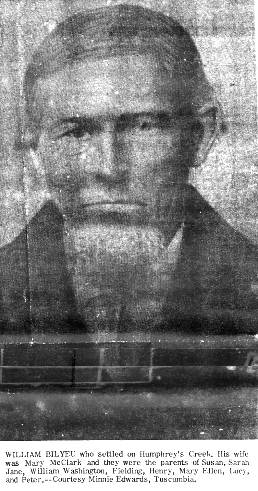
07 William Bilyeu
Click image for larger viewNo photo of their son William Washington Bilyeu, Eula’s great grandfather, was available. John Henry Bilyou, Eula’s grandfather, is pictured here with his wife, Ida Adaline Jones and their children (photo 08).
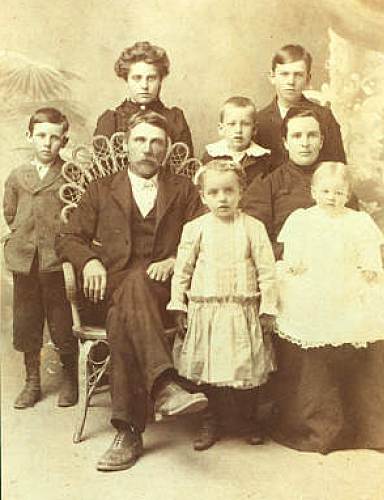
08 John Henry and Ida Adeline Bilyeu, Nellie Sophia, Lewis Clyde,
William Howard, Leonard Luther, Allie Dorcas and Minnie Belle Clyde Bilyeu, son of John Henry and father of Eula, is pictured here with his wife, Lou Addie Keeth Bilyou (photo 09).
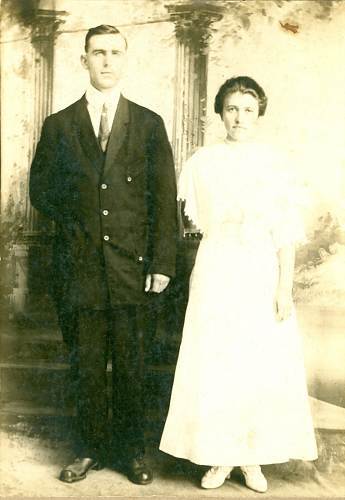
09 Lewis Clyde Bilyeu and LouAdie (Keeth) Bilyeu - July 12, 1912 The next photo is of the sisters of Clyde Bilyeu, all who are children of John Henry and Ida (photo 10).
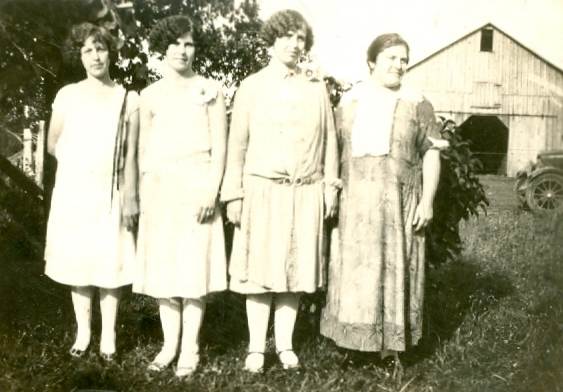
10 Minnie, Ora, Allie and Nellie - Daughters of John and Ida Bilyeu Minnie Bilyeu, one of the ladies in the photo, was the wife of John Edwards, and grandmother of board member, Karen Wyrick Smith.
The next photo is of Eula and members of her family taking a boat trip on the Osage River on a visit to Minnie and John Edwards, who lived down river from Tuscumbia on a large farm (photo 11).
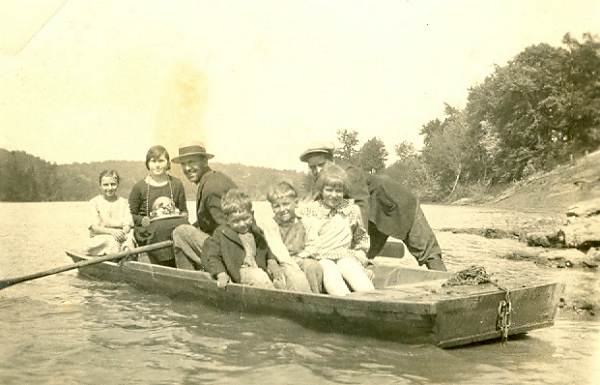
11 Eula on a Boat Trip on the Osage River The next photo is of what was written on the back (photo 12):
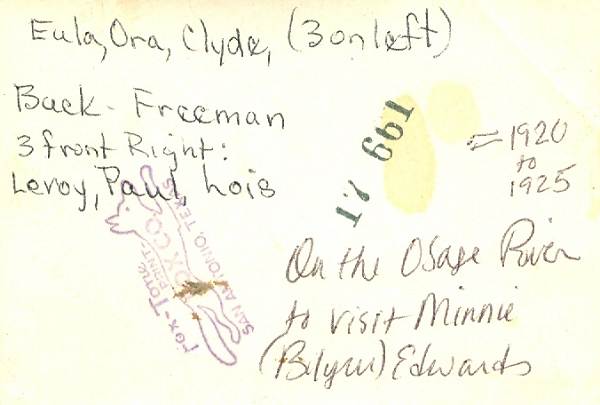
12 Eula Boat Trip Caption The photos above were provided by Jamie Patterson from her grandmother Eula’s collection.
Another Miller County Bilyeu who was well known was Fielding Bilyeu (photo 13).
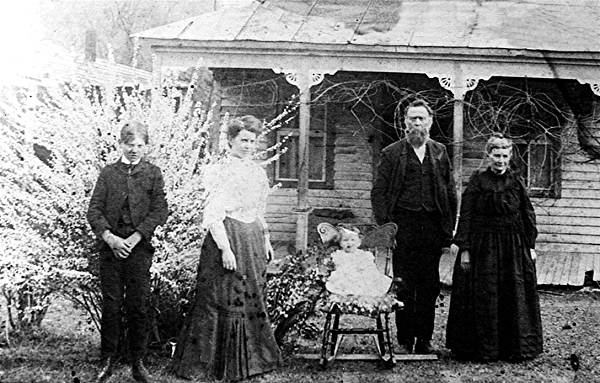
13 Fielding and Mariah with granddaughter Jewell, daughter Hilda and son John - 1906 Fielding was a brother to William Washington Bilyeu and was the uncle of John Henry Bilyeu, Eula’s grandfather. To make matters really confusing, Fielding had a son he also named John Henry Bilyeu, born in 1893. Eula’s grandfather, also named John Henry, was born in 1868.
Another well known Miller County Bilyeu was Frank Bilyeu (Francis Marion Bilyeu) (photo 14).
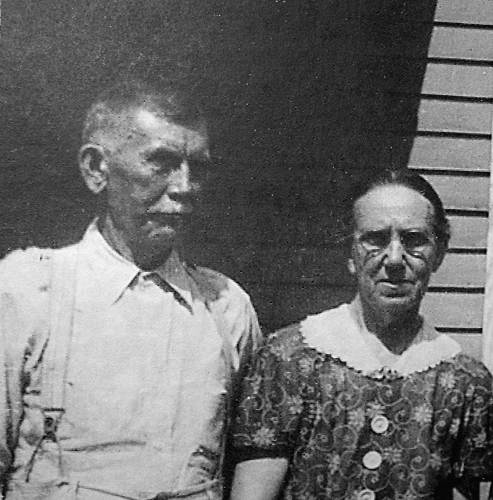
14 Frank and Paradine Bilyeu He was a great uncle of Eula’s being a brother to John Henry Bilyeu, Eula’s grandfather.
The Bilyeu family genealogy has been of great interest over the years having been researched by quite a number of genealogists which you can discover for yourself by recurring to the internet for information about the family.
However, Jamie Patterson recently researched her own Bilyeu descendency a copy of which is presented here:
Jamie Fischer Patterson
1) Parents
Roger Fischer
Katheryn Cogburn
2) Grandparents
Bryce Fischer
Eula Bilyeu
3) Great-Grandparents
Clyde Bilyeu
LouAddie Keeth
4) Great-Great Grandparents
John Henry Bilyeu
Ida A. Jones
5) Great-Great-Great Grandparents
William Washington Bilyeu
Rebecca Ann Crane
6) Great-Great-Great-Great Grandparents
William M. Bilyeu (born 1809)
Mary McCart
7) Great-Great-Great-Great-Great Grandparents
John Bilyeu (Maryland)
Sarah “Sally” McGrew
8) Great-Great-Great-Great-Great-Great Grandparents
John Bilyeu (Somerset County, NJ)
Tryntje Barnets
9) Great-Great-Great-Great-Great-Great-Great Grandparents
Peter Bilyeu/Billiou (Staten Island, NY)
Maragrietje\Maria ?
10) Great-Great-Great-Great-Great-Great-Great-Great Grandparents
Isaac Bilyeu/Billiou (Born at sea between Leyden, South Holland and North America; MB August 10, 1661)
Ida Sueberingh (1664 in Bergen, New Jersey; MB Staten Island, New York)
11) Great-Great-Great-Great-Great-Great-Great-Great-Great Grandparents
Pierre “Peter” Billiou (17 JUN 1632 in Reins, Normandy, France; MB 1625 Lille, France or La Bassee, Wicres, French Flanders
Francoise Du Bois (17 JUN 1625 in Reins, Marne, Normandy, France)
One of the best websites I found about the Bilyeu family can be found here.
The section which pertains to Miller County Bilyeu family members can be found here.
However, there is something about Clyde Lee Jenkins’ history of the Miller County Bilyeu family which makes it somewhat unique since much of his information was obtained as oral history. He had the opportunity to talk with a significant number of Bilyeu family members beginning in the 1960’s when quite a number were still alive who had known some of their earlier Miller County Bilyeu ancestors. This is a long article and because it discusses people who lived here so many years ago, few photos are available to accompany it. However, I wanted to place it on our website because references to it abound in the various resources I reviewed concerning the Bilyeu family.
First Bilyeu Came To Miller County Over 150 Years Ago
The Eldon Advertiser, October 26, 1972
Clyde Lee Jenkins
The first Bilyeu in what is now Miller County was, without any doubt, Isaac. He appeared in the Gasconade River country on a hunting expedition in late 1818, and having found game so plentiful, camped for more than a year near the Shawnee villages by the Big Maries River. During this time he made several excursions into the wilds of the Big Richwoods with Indian Chief Rodgers, hunting for deer and bear.
An excellent hunter, old Chief Rodgers was a white man, having been removed from the breasts of his mother by Indians raiding settlements near the falls of the Ohio River before the Revolutionary War.
Isaac found wild game in the Big Richwoods so abounding that he raised a log cabin near the mouth of the Atwell, Johnston, and Little Tavern forks, probably on land now owned by Leonard Keeth.
In the summer of 1820, having married an Indian maiden, Isaac moved with his new bride, both under 20 years of age, into their log cabin home. Their closest neighbors were John Wilson by the Barren Fork Creek, and Daniel Brumley by the Big Tavern Creek to the north.
Isaac kept his wife supplied with sugar by gathering wild honey. Every season, at the Missouri River, he got salt from the canoes coming down from the Boone’s Lick. For three or more years he got corn from James Harrison at the mouth of the Little Piney River. He kept the corn inside his cabin, concealed in a hollow log barrel, and when needed for bread stuff, a small portion of the grain was placed in a bowl shaped rock and crushed with a round stone by hand. The bear and deer furnished meat for food, and skins for leather breeches, skirts, jackets, moccasins, and hammocks.
Having a trio of Indian dogs for chasing bear made Isaac a wealthy hunter. These animals were vicious, a cross between early puritan mongrels and domesticated prairie wolves.
In fact, it may be said, Isaac hunted like an Indian, was married to an Indian, and generally, lived like an Indian.
Little or nothing is known of his ancestors, and upon his death in late 1829, his wife returned, with at least two children, to her own people. Without any doubt he was a relative of the Bilyeus who commenced entering the area before his demise. In fact, he may have been a son of the Isaac who followed him.
Isaac Bilyeu, born in Maryland in 1780, grew to manhood there, then, after his marriage to Mary Ann, moved into Tennessee, where they settled in Overton county about 1799. Their known children included Jacob, born 1803; Mary Ann; John Witten, born 1809 (photo 15); Elizabeth, born 1813; Margaret Ann, born 1821; and Stephen, born 1826.
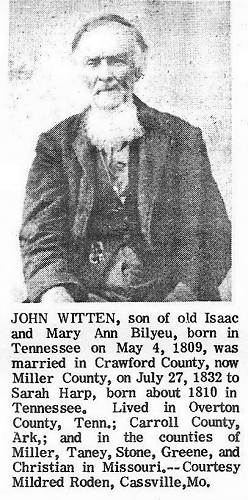
15 John Witten Bilyeu
Click image for larger viewDuring the War of 1812, Isaac served in the First Regiment of Bradley’s Tennessee Volunteers. After the war he moved with his family into Green County, Kentucky, and from this point in time, Isaac was always on the go, following the fur trade.
During the 1820’s he often visited the area now Miller County. His first trips were made to obtain saltpeter, a necessary ingredient in the manufacture of gunpowder. The soil in the floors of the many caves in Central Missouri, heavily saturated with nitrate of lime, when leached with wood ashes, yielded nitrate of potash. In this manner saltpeter was manufactured by the patriots in Kentucky and Tennessee for the government during the War of 1812.
By 1830, Isaac Bilyeu and his family were situated in present day Glaze Township, Miller County, then Crawford County, Missouri.
Jacob, the eldest known son of Isaac and Mary Ann, was married to Catherine Elizabeth Williams, a daughter of William Williams and Sarah Ann Sullens Williams. They lived in Miller County until the middle 1840’s, then moved to Taney County, Missouri, and after a few years there, moved to Carroll County, Arkansas, where Jacob died in the early 1850’s. He was buried at the head of the Big Indian Creek.
After Jacob’s death, widow Catherine Elizabeth lived wherever she could find a home; mostly with her brother, Rivers Williams, in Taney County; her children scattered among relatives. One son, Hosea, lived with his uncle, John Witten Bilyeu (photo 16).
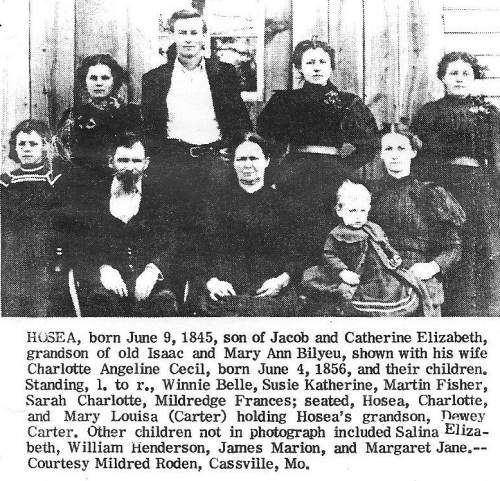
16 Hosea Bilyeu - Grandson of Isaac and Family
Click image for larger viewHosea, in 1866, was married to Charlotte Angeline Cecil in Christian County, Missouri. Another son, James Marion, eventually settled in Hunt County, Texas.
Mary Ann, daughter of Isaac and Mary Ann Bilyeu, was married to John T. Davis, and they settled in Pulaski County, Missouri, in 1835, now Osage Township, Miller County. In the first election ever held in the new county of Miller on July 1, 1837, the log cabin home of John T. and Mary Ann was the polling place for voters in Osage Township. He was an associate justice of the Miller County Court from 1838 to 1840; president of the County Court from 1840 to 1843. He served as county treasurer in 1840, most of ’41, and all of ‘32, ‘43 and ’44. He was sheriff and collector from 1844 to 1846. He erected the first courthouse and jailhouse in Miller County. He was an officer in the Miller County Militia.
In the winter of 1846, when the County Court removed Judge Davis as superintendent for the improvement of the river bank at Tuscumbia, he soon left the place, moving with his family to Taney County, Missouri.
John Witten Bilyeu, son of Isaac and Mary Ann, was married in Crawford County, Missouri, now glaze Township, Miller County, on July 27, 1832, to Sarah Harp, born 1810 in Tennessee, the ceremony performed by Squire Andrew Bilyeu. Like his father, John Witten Bilyeu was possessed of a roving nature. He was situated in present day Glaze Township from 1830 through 1837, a postmaster in Carroll County, Arkansas, in 1838, back in Miller County before 1840, in Taney County by 1848, in Greene County during the Civil War where he served under Captain Galloway in Company L of the Stone County Home Guard. He died March 2, 1898, at Spokane, in Christian County, Missouri, during the 88th year of his lifetime (see photo 15 above).
John Witten Bilyeu and his wife, Sarah Harp, were the parents of nine children; the first two, Wietie and Mildredge, born in the area now Miller County. Wiette, born December 25, 1835, first married Mary Jane Lewallen. Mildredge, born in 1837, married Daniel, son of old Daniel by his second wife.
Other children of John Witten and Sarah included Isaac, born October 1, 1838, who married Charity Hammond; John Henry, born May 19, 1840, in Miller county who married Catherine Hands; Jacob M. born June 20, 1842, who married Susan Elizabeth Cecil; Martha, born September 13, 1844, who married John Sewallen; Stephen, born October 25, 1846, who married Elizabeth Lewallen; Martin Fischer, born February 24, 1849, who married Ellen Hilton; and Caldona, born February 11, 1852, who married Thomas Williams.
Note: I cannot let the further story of John Witten Bilyeu be ignored as it is fascinating. He and his wife Sarah moved to Christian County as Clyde Lee mentioned above. Members of their family were involved in a shootout there which is well described at this website.
You will need to scroll half way down the page to reach the section about John Witten.
Elizabeth, a daughter of Isaac and Mary Ann Bilyeu, was married to Henry C. Clinkenbeard, born about 1808 in Kentucky. They lived for a while in Tennessee after marriage, then moving into Illinois and lived there approximately three years before moving to Pulaski County Missouri where they settled, in 1835, southwesterly of Iberia now, by the creek which bears their name. They moved around considerably living in Arkansas and Missouri. Their children included Dianna, who married Carter Harp; Elizabeth, who married John S. Mahan; Mary Ann or Polly, first child born in the area now Miller County, who married William Moore; Lydia Ann, who married William Henry Leonard; John, born December 24, 1841, in Tuscumbia, Missouri, who married widow Elizabeth Moore; William, who married Matilda Sanders; Hyrum, who married first American Razor, and second, widow Mariah Johnson. Four other children were Isaac, Nancy, Martin, and Greenberrry, but whom they married is unknown to this author.
Margaret Ann, daughter of Isaac and Mary Ann Bilyeu, was married on October 21, 1838, in Carroll County, Arkansas to Martin T. Melton, born December 10, 1817 in Indiana, a son of Reuben Melton and Allie McAdams.
Stephen, the last known child of Isaac and Mary Ann Bilyeu, was married to Fannie M. Baker, born 1830 in Missouri. Her father was Aaron Baker whose parents were old General John Baker of South Carolina and wife, the former Barbara Schell. Stephen and Fannie M. were the parents of Sarah E., Isaac A., Mary Ann, John S., Barbara, Margaret, Alice and Adam.
It is known that Isaac Bilyeu, the old fur trader, was living with his son, Stephen Bilyeu, in Carroll County, Arkansas in 1860, in the 80th year of his lifetime. It is believed he died soon afterward; his wife, Mary Ann, having died a few years before in Taney county, Missouri.
William Bilyeu journeyed from Illinois into the area now Miller County as early as 1831 to visit relatives. He was a miller by profession, and while in Central Missouri found a suitable site for a grist mill by the Big Tavern Creek. He returned with his family to Tennessee, but by 1835 was back in the Big Richwoods, cracking corn for the inhabitants. The mill stones were powered by a water wheel pushed by the current of the Big tavern Creek. Even though 137 years have passed since its building, the millrace is visible today. Bilyeu’s mill was situated where the Big Tavern watercourse is now crossed by Highway 42, northeasterly of Iberia.
William Bilyeu, born in Kentucky on March 17, 1795, served in the War of 1812 as a private in Captain John Kennedy’s company of the First Regiment, Western Tennessee Militia Volunteers, in General Jackson’s campaign against the Creek Indians, and was honorably discharged from the service, at Monroe, in Overton county, Tennessee.
On December 30, 1916, he was married in Overton County, to Diannah Coker, born in 1801 in Kentucky. They were the parents of 12 children, nine born in Tennessee, one born in Illinois, and two born in Missouri. Their eldest child was Lydia, born in 1817, who was married in 1835 to William Kinder in Pulaski County, Missouri, now Miller County. William and Lydia were the parents of Nancy, born in 1836; John, born in 1838; Greenup, born in 1841; and Hubbard, born in 1843. Lydia died in Miller County, Missouri in 1844, and William then married her sister.
Nancy, the second child of William and Diannah, was born on January 27, 1819, in Overton County, Tennessee. She was married to John Smathers on October 2, 1838, in Miller County, Missouri. They were the parents of three children, William Henry, Nancy, and Bertha. John Smathers was killed while on a hunting expedition in the Kinderhook country in 1841, and his widow, Nancy, then married William Richmond McCubbin on September 18, 1842, in Miller County.
William R. McCubbin, born May 18, 1815, in Kentucky, and Nancy, were the parents of Diannah, born November 27, 1843; John Hubbard, born October 25, 1845; Elizabeth, born February 8, 1850; Lucinda, born March 23, 1854; Thomas Pleasant, born February 14, 1856; and Rhoda, born February 11, 1859. The Smathers children by Nancy, and the first three McCubbin youngsters were born in Miller County, the remainder in Oregon.
George W., the third child of William and Diannah, was born in 1820, in Overton County, Tennessee. He was married to Hester Jane Reed on July 24, 1839 in Miller County. They were the parents of William, born in 1841; John born in 1842; Lucinda, born in 1846; Hubbard, born in 1848; Jackson A. born February 12, 1851; Elizabeth, born in 1852; Peter, born in 1855; Amanda, born in 1856; Martin, born in 1858; George, born in 1860. Jackson A, was the last child born in Missouri, the remainder in Oregon, including six more children whose names are unknown to this author
Julia Ann, the fourth child of William and Diannah, born in Overton County, Tennessee, in 1822, was married to William Kinder on May 27, 1845, in Miller County. Julia Ann was a sister of William’s first wife, Lydia. At least two of their children were born in Miller County, Alva, born in 1846; and George, born 1848.
John Martin Van Buren, the fifth child of William and Diannah, was born on February 22, 1822, in Overton County, Tennessee. On February 20, 1844, he was married to Hannah J. Wasson in Pulaski County, Missouri. Soon after their marriage they moved into Miller County, and were the parents of William, born 1846; Jacob, born 1848; Deannah, born 1850; and Sarah, born 1851, before they departed from Miller County. Several more children were born in Oregon. John Martin Van Buren Bilyeu, known as “Little John,” died in 1903 at Scio, Oregon.
Hubbard, the sixth child of William and Diannah, was born in Overton County, Tennessee, in 1825. He was married to Mary Ann on January 9, 1850. All of their children were born in Oregon.
Lucinda, the seventh child of William and Diannah, was born in Overton County, Tennessee, in 1828. On August 19, 1847, she was married to John Bryant in Miller County. They were the parents of Hubbard, born in 1849, and Susan, born in 1854 before they departed from Miller County. More children were born to them in Oregon.
Andrew Jackson, the eighth child of William and Diannah, was born in Illinois. He was yet single when he left Miller County, taking a wife, and raising a family in Oregon.
William Jr., born there in 1835; Peter, born in Miller County in 1837; and Martin, born here in 1839, were the other children of William and Diannah Bilyeu. They married and raised families in Oregon.
William Bilyeu and Diannah Coker remained in the Big Richwoods until 1852. Then they got the fever! Peter Bilyeu, having already settled in Oregon, returned to take them up the Trail into the great Northwest. In the spring of 1852, with the customary ox teams, this entire family, 52 in number, with others, commenced the westward trek. After a journey of six months and ten days across the plains by way of the Platte River and over the old Barlow road, they entered the promised land, on September 16, and engaged at once in farming.
Other relatives crossing the plains in 1852 were not so fortunate. One group, headed by Captain Peter Neal, who married Mahala Bilyeu, in the train commanded by Captain Cornelius Gilliam, lost many members. Except for one child the entire family of Valentine Neal, a brother to Captain Peter, died on the trail.
Hubbard Bilyeu, a brother of William who married Diannah Coker, was the father of at least five daughters. Four of them married Neal brothers, but the fifth Neal brother balked, saying one more would be too many. The Neal boys were children of old Cornelius O’Neal of North Carolina and Virginia, later situated by the Nolechucky in Green County, Tennessee, before coming to Missouri. The surviving child of Valentine Neal’s family was taken in by brother, Calvin, who married Alcy Bilyeu.
The children of William Bilyeu and Diannah Coker became outstanding citizens in Oregon, but Nancy, who married William R. McCubbin, must be especially mentioned, since she raised, beside her own children by two marriages, 11 orphan children to adulthood. These included Bert Foster, Adrian Skymer, Eugene Arthur, William Healis, Edna Bacon, Albert Garrison, Ralph Bacon, Roxy Rhoadermel, Celia Garbeson, Ephraim Barnes, and Jane Elizabeth Potter.
An industrious woman, once a week Nancy rode into town, astride a little mule, peddling eggs, butter and produce to Oregon merchants for staples needed on the farm. By her own admission, she daily baked a “wagon load” of biscuits. One morning, having closed the door upon an oven filled with biscuits, she was startled by several loud cat squalls, but paid no heed, thinking the yelling feline was in the yard outside. However, upon opening the oven door, old tom, the household pet, was found baked with the biscuits, the cat having jumped in the oven before the stove was fired and the oven door closed. Dumping the old tom outside, the hairs were brushed from the biscuits and then rapidly consumed by hungry mouths around the dinner table; no lamenting given the cat’s demise. Nancy died on February 6, 1901, and was buried in the Logan Cemetery near Oregon City, Oregon.
Like his father William, when in Miller County, George W. Bilyeu, who married Hester Jane Reed, was the proprietor of a grist mill in the Jordan Valley of Oregon a number of years. He died February 6, 1898, at Scio, Oregon, in the 78th year of his lifetime.
About 1832, Andrew and John Bilyeu arrived in the northernmost reaches of Pulaski County, Missouri, now Miller County. Natives of Maryland, they were of French Huguenot descent, and relatives of William Penn, founder of the Pennsylvania Colony. John settled in the Big Richwoods, Andrew in the Little Richwoods, and their children settled around them.
Generally, they had traveled out of Maryland into Virginia, then from the Old Dominion state into the Carolinas, through Tennessee, Kentucky, Indiana, and the country of the Illinois before entering Missouri; some traveling one route, some another.
Andrew Bilyeu, born in Maryland, about 1792, was married to Anna, born in South Carolina, about 1788. They settled near present day Ulman, where he served as a justice of the peace, first in Crawford County, then in Pulaski County, and after 1837, in Glaze Township Miller County. Their children included Simon Peter, Lydia, Betsy Ann, John R., and Mary or Polly.
Simon Peter was married to a woman named Mary, and upon her death, about 1844, was left with a number of children. On April 4, 1854, he was married to Matilda Smith, and they moved to Camden County, where he died in the early 1860’s leaving heirs in Camden and Osage counties.
Lydia, born about 1825, in Kentucky, was married to Felix G, Hale, on November 27, 1842. Betsy Ann, born about 1828, in Illinois, was married to Alexander Colvin on March 12, 1846. During the 1850’s, they lived in Richardson county, Nebraska but returned to Miller County before the Civil War.
John R., born in 1818, was married to a woman named Elizabeth, born in 1817, both natives of Tennessee. They were the parents of Andrew Jr., Diannah, William J., Simon N., and Minerva. Upon John R.’s death in 1861, he owned approximately 700 acres in the flatlands of the Little Richwoods. An inventory of his personal property, on January 3, 1862, revealed among many items, a scythe and cradle, a no. 1 Jewett plow, a no. 2 Jewett plow, a diamond plow, 2 sets of harness, 2 mules, 11 horses, 29 head of cattle, 19 calves, 5 sheep, and 14 hogs, besides numerous stacks of Hungarian and timothy hay, oats, rye, and wheat, and 154 shocks of corn, having an appraised value of $522.91.
John R’s widow, Elizabeth, died in 1875. Of their children, Andrew Jr., was living in Moniteau County, while Diannah, having married Ephraim Wychoff on September 17, 1871, was living in Miller County. So were William J., Simon N., and Minerva. William J. lived near Ulman, having married Linonatt Brumley, a daughter of William Carroll Brumley, on January 25, 1872. They were the parents, before her death, of William C., who died July 14, 1891, Clayton, and Francis. William J. engaged in the raising of apples, having an orchard of Limber Twig, Winesap, Ben Davis, and Jenneton trees. He died October 7, 1888, and 363 bushels of apples were sold at his estate sale on October 25, 1888, John W. Waite, clerk.
Other Bilyeus were in the Little Richwoods country who left the area before 1850. Names can be obtained from many sources and an example will be given. In May, 1841, John Brockman, while surveying a state road from Tuscumbia to Springfield, Missouri, reported that, having run from the Dog Creek, passed “through poor barrens to the Little Richwoods, which is a settlement of fertile lands. William Bilyeu relinquished the right of way. Thence to the land of John R. Bilyeu, he relinquished the right of way. Thence through the land of Simon P. Bilyeu, non resident, no damages assessed, to land of Emly Golden. He relinquished the right of way. Thence to the land of John R. Bilyeu, he relinquished the right of way. Thence to the land of Lydia Bileu, a nonresident, no damages. Thence to the land of Jesse Gott” and on to James Gentry at Mill Creek.”
John Bilyeu, born in Maryland, in 1775, settled in the Big Richwoods, northeast of Iberia, in the Bray’s country. He was married to Rachel, born in 1810, a native of Kentucky. No doubt she was a second wife. Their children included Isaac, William, Cornelius, Joseph, Mary or Polly, Delilah, Lydia, James, John, Didama, Susannah, Peter, Sarah, Andrew Jackson, and Larkin.
In the war with the Creek Indians, John had fought under General Jackson, serving as a private in the First Regiment of Bradley’s Tennessee Volunteers. He rushed to arms on October 4, 1813, to avenge the frightful massacre of nearly four hundred men, women, and children at Fort Mimms in Alabama on August 30. At Talladega, Alabama, on November 9, the Tennessee troops engaged the Indians, killing nearly 300 warriors. After two more battles in November, and one in December, in which the Indians were defeated with great slaughter, John returned home.
Cornelius, born in Tennessee in 1815, was the first of John’s children to die in Miller County. He was married to Liza Jane McClain on September 16, 1838, and before her death in 1843, they were the parents of Dee, John W., and William J. Soon afterward, on March 1, 1846, Cornelius was married to Malinda Melton. They were the parents of Eliza Jane, Reuben M. James Simpson, and Green Berry. Daughter Eliza Jane was married to John T. Thompson on October 16, 1865.
Cornelius suddenly died in 1856 and the personal property belonging to his estate was sold on September 4. Items auctioned included one yoke of oxen, purchased by William Gibson for $46; a young horse, purchased by Thomas Anderson for $66; a mule colt, bid in by James Morrow for $46.75; a rifle gun to James Bolen for $8l25; a wheat fan to P.G. Turner for $8.25; a wheat fan to P.G. Turner for $8.25; thirteen head of sheep, purchased by E.L. Short for $18.25; total amount of sale, a sum of $207.10. On January 11, 1859, widow Malinda, was married to Elijah Pitman, a widower, and a native of North Carolina, living in the Big Richwoods. Nellie C. Dodd, on March 31, 1869, was paid $1.60 for tuition for schooling of Reuben M. Bilyeu; and Dr. W.M. McAdams paid a small sum for medical attention to Melinda’s children.
Peter, born September 29, 1802, in Kentucky, was the first of John’s children to move to Oregon. On March 18, 1821, he was married to Mary Jane Dyer in Tennessee. When Miller County was established as a governmental unit, he was elected a justice of the peace in Richwoods Township, serving a number of years. He was an officer in the Miller County Militia. In the spring of 1850, with others, he crossed the plains, arriving in Oregon on October 17. His glowing reports on the fertile land there was reason enough for others in Miller County to want to follow him. In the spring of 1852, returning to Richwoods Township, he led a wagon train of Miller Countians to Oregon, arriving on September 16. Peter died on July 27, 1877; his wife, Mary Jane Dyer, born December 4, 1801, died April 9, 1878, both at Scio, Oregon.
They were the parents of a number of children, one daughter, Nancy, born in January, 1822, having died in Miller County on October 1, 1849. Their eldest son, John L. Bilyeu, born July 23, 1824, who marred Nancy Workman in Illinois on March 9, 1848, arrived in Oregon on August 19, 1853. They were the parents of 14 children. George, born in 1826, moved to Oregon with his parents, Peter and Mary Jane.
Sarah, daughter of John Bilyeu who married Rachel, was married to Daniel McLaughlin in Miller County on December 26, 1838. They were the parents of Rachel, John, Bluford, and Priscilla before moving to Oregon.
Joseph, son of John Bilyeu who married Rachel, was born near Cumberland, Tennessee, in 1823. He moved, with his parents into the area now Miller County, when seven years of age. On September 25, 1842, he was married to Anna Osborne in Miller County. Born in Sangamon County, Illinois, in 1825, she was a daughter of William Osborne, a farmer, who died in that state.
Joseph cleared a wilderness farm in the Big Richwoods of Miller County, and improved upon his holdings until 1860; the he sold out, and moved to Putnam County. Soon afterward, with the customary ox and horse teams, having outfitted a number of wagons, he left Missouri, with others, on May 5, 1862, moving up the Oregon Trail. They camped by the Columbia River for three days in September, and on October 7, 1862, entered Portland, Oregon.
Joseph settled in Linn County, but soon moved to Polk county, where he purchased a farm and engaged in agricultural pursuits for many years. Later, he farmed in Marion County, where his wife, Anna, died in 1899. He then moved to Albany, Oregon, where he died on May 29, 1902.
Joseph Bilyeu and Anna Osborne were the parents of 10 children, John, William R., Larkin, John, James, Lydia, Tabitha, Joseph, and one infant who died after birth on the Oregon Trail. Joseph was the only child born in Oregon, and he died in Linn County when 20 years of age. John, born in 1845, and Larkin, born in 1849, died in Miller County, but their names were given to succeeding children. The second John died in Linn county, Oregon, when 27 years of age. The children of Joseph and Anna became prominent legislators, lawyers, and educators in the state of Oregon.
Continuing with the children of John Bilyeu, husband of Rachel, his daughter Polly, or Mary, was married to William H. Melton on November 12, 1843 in Miller County. Polly, a native of Illinois, was born in 1824; her husband, a native of Indiana, born in 1815. Daughter Delilah was married to an Osborne, believed to have been a brother of Joseph’s wife, Anna, and they lived in Illinois. Daughter Lydia was married to Samuel Parrack in Miller County on February 4, 1841, and soon afterward, they moved to Illinois. Daughter Didama, who married John Denny, a native of Poland, on January 21, 1821, lived in Indiana. So did sons John and James, raising large families in the Hoosier state. Daughter Susannah was married to a Carmack, and they lived in the state of Tennessee. Two of John’s sons, Isaac, who settled on the Cattail fork of Dog Creek, and William, who settled on Humphrey’s Creek, remained in Miller County.
John Bilyeu, father of the aforementioned children, died at his home in the Big Richwoods, near Bray’s Mill now, on January 21, 1853. He was a farmer and blacksmith. By will, he had given his plantation, livestock, mechanical, blacksmith, and farming tools to his widow, Rachel, and upon her death, or marriage, to his sons, Andrew Jackson and Larkin, equally. The sale of personal property belonging to his estate was held on March 15, 1853; 400 pounds of bacon excepted to the use of the widow.
John Bilyeu was truly an outstanding pioneer citizen. Having entered the Big Richwoods when the Indians were leaving it, he cleared a wilderness farm in the area now Miller County. His large family carried the Bilyeu name from Maryland to the shores of the Pacific Ocean. His son, Andrew Jackson Bilyeu, was at home upon his death, but what became of him is unknown to this author. His youngest son, Larkin, was also at home, and he married Ann Liza Runnels on August 16, 1855, and they lived with his mother, Rachel. What happened to Ann Liza Runnels is also unknown to this author, but in the autumn of 1861, Rachel’s place in the Big Richwoods was raided by sympathizing forces moving South; her cattle, livestock, and provisions taken, and the torch put to her buildings. Rachel then moved to Lebanon for protection; Larkin joined the Union Army. While a member of Company D, 24th Missouri Infantry, he died at Rolla, Missouri of measles, on December 23, 1861, in the 22nd year of his lifetime. He was buried by Polly and William Melton, his sister and brother in law, who were living near Rolla at this time.
Issac Bilyeu, son of John who married Rachel, born about 1813 in Tennessee, was married to Mary or Polly, born about 1820 in the same state. After their marriage in 1840 they settled on the Cattail fork of the Dog creek in Miller County. They were the parents of Nancy C., born 1841, who married George T. Martin on April 24, 1870; Andrew,, born 1843, who married Amanda Wyrick on January 5, 1862; Richmond B., born 1849, who married Nancy Barton on March 15, 1869; Sarah Ann, born 1852, who married William P. Martin on April 24, 1870; and Mary, born 1859; who married Thomas Lamb on August 26, 1875.
On January 29, 1897, Andrew Bilyeu, while attending circuit court as a juryman in Tuscumbia, was taken violently ill, and immediately carried to his room at Judge Bacon’s hotel. He was soon unconscious, paralyzed from meningitis, and during the night, without having regained consciousness, died. The following morning his body was carried over the river by his brother in law, William P. Martin, to be interred beside his father and mother.
William Bilyeu (see photo 07 above), son of John who married Rachel, settled on Humphrey’s creek. Born about 1809 in Kentucky, he was married to Mary McClark, also a native o Kentucky, born about 1815. They were the parents of Susan, born in 1834; Sarah Jane, born December 25, 1837, who married James C. McDonald on December 20, 1858 (photo 17); William Washington, born February 7, 1840, who married Rebecca Ann Crane on February 16, 1860; Fielding, born December 28, 1842, who married Marian Capps on March 1, 1868; Henry, born 1845, who married Mary E. Capps in 1873; Mary Ellen, born 1841, who married Andrew J. Pendleton on December 8, 1867; Lucy, born 1854, who married Richard L. Ramsey, on December 25, 1870; and Peter, born 1857, who married Caroline Stark on February 17, 1864.
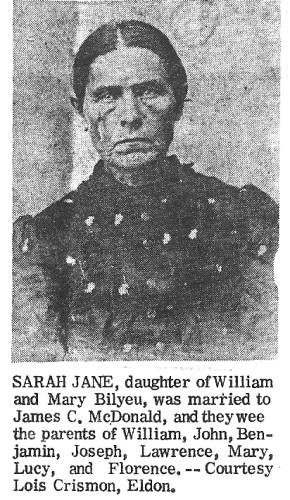
17 Sarah Jane Bilyeu McDonald
Click image for larger viewWilliam Washington Bilyeu, son of William and Mary, was born near Paoli, in Orange County, Indiana. As a boy he came with his parents to Miller County. On August 21, 1862, when 22 years of age he was enrolled in Captain Henry Cochran’s Company E, 33rd Regiment of Missouri Voluntary Infantry; honorably discharged from the service on August 19, 1865 at Benton Barracks in St. Louis. He died on June 3, 1912.
William Washington Bilyeu and Rebecca Ann Crane were the parents of James, Jeff, John Henry (photo 18), Frank, Clinton, Lewis, Martha, Mary, Charles, Sarah Jane, and Walter.
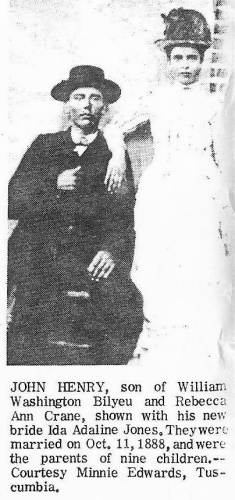
18 John Henry - Son of William Washington Bilyeu
Click image for larger viewFielding Bilyeu, son of William and Mary, was born in Orange County, Indiana (photo 19).
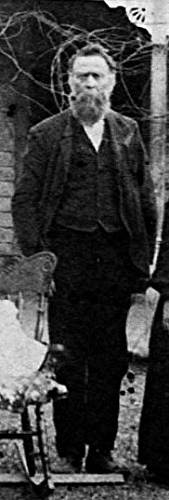
19 Fielding Bilyeu When 19 years of age he enlisted in Company H of the Osage Valley Regiment of Home Guard, then on August 22, 1862, was enrolled in Captain Henry Cochran’s Company E, 33rd Regiment of Missouri Voluntary Infantry; honorably discharged from the service on August 10, 1865 at Benton Barracks in St. Louis.
Fielding Bilyeu and Mariah Capps were the parents of Laura E., Julia a., Arthur A., Austin E., Evelyn L., Everett, Hilda V., Linnet E., Roscoe R., Vesta L., and John H.
In May, 1909, while Fielding Bilyeu was postmaster at Ramsey, the post office located in his home, a tornado destroyed his dwelling and outbuildings. He died on December 21, 1928.
Mary Ellen Bilyeu lived for many years with her husband, Andrew Jackson Pendleton, on a farm where the village of St. Anthony is now situated. They were the parents of Ulyssus J., Mattie, Henry, Owen, Iva, Harvey, Perry, and Everett.
Henry Bilyeu and Mary E. Capps, before his death, were the parents of Augustien or Gusta, Charles Wesley, and Leona or Ona.
Lucy Bilyeu died a few years after her marriage to Richard L. Ramsey. He then married Mary E. Capps, widow of Lucy’s brother, Henry.
Children of Peter Bilyeu and Caroline Stark known to this author included Clara, Dona and Blanche.
The author is especially indebted to Mildred Rodden of Cassville, Missouri; Mrs. John S. Lowery of Falls Church, Virginia; Evelyn Slapnik of Greenville, California; Wythle Brown of Portland, Oregon; Professor B.K. Swartz Jr. of Muncie, Indiana and many local citizens for information.
The most difficult thing for me on reading the family histories of our antecedents of a couple centuries ago was the tendency of parents to give their children exactly the same names as other relatives gave their children. That was certainly true with the ones named John Henry. I identified at least three John Henry’s in Clyde’s narrative above: one born in 1840, one born in 1868, and another born in 1893.
In the article above by Clyde was mentioned Peter Bilyeu, who took a number of people with him to Oregon where the group settled land and established a large contingent of the Bilyeu family which has persisted to this day. Quite a number of people in those days were leaving this area to go west, especially to Oregon and California. Peter Bilyeu was the great great great grandfather of our Miller County Historical Society’s revered historian, Peggy Hake. She writes about him in an article about her Bilyeu family history on our website:
JOHN BILYEU FAMILY
John Bilyeu was my great-great-great-great-grandfather, who was born in Maryland circa 1775. He was a descendant of early immigrants to America, Pierre and Francoise (DuBois) Billiou, who were French Hugenots from LaBasse in French Flanders. They were part of the religious sect called Walloons, a segment of the Huguenots.
In the 17th century, LaBasse was part of Belgium territory. Pierre and Francoise came to America in 1661 and settled what is today Staten Island, New York. The later Billiou/Bilyeu families moved to New Jersey, Pennsylvania and Maryland…then on to East Tennessee…to Indiana and Illinois…and finally many of the Bilyeu families came to Miller County, where their descendants remain today. Typical of many pioneer families, some of the Bilyeu ancestors continued to move west and settled in Oregon Territory. The Pacific Ocean put a stop to the overland migration!
John Bilyeu, my ancestor, married Sarah McGrew in the late 18th century…the place not known.
· They became parents of at least 13 children including:
· 1. Peter Bilyeu b. 1802 m. Mary Jane Coker 1821
· 2. Isaac Bilyeu b. c/1811 m. Mary/Polly Bilyeu
· 3. William Bilyeu b. c1809 m. Mary McClark
· 4. Cornelius Bilyeu b. c/1815 m. 1-Eliza Jane McClain 1838
· 2. Melinda Melton 1846
· 5. Joseph Bilyeu b. c/1823 m. Ann Osborne 1842
· 6. Mary/Polly Bilyeu b. c/1824 m. William H. Melton 1843
· 7. Deliliah Bilyeu b.____ m. Larkin Osborne
· 8. Lydia Bilyeu b. ______ m. Samuel Parrack 1841
· 9. John Bilyeu b.______ m. Mary Tyler
· 10. James Bilyeu b.______ m. Eunice Alexon
· 11. Didama Bilyeu b.______ m. John Denny 1821
· 12. Susannah Bilyeu b. ______ m. ________Carmack
· 13. Sarah Bilyeu b.______ m. Daniel McGlothin/McLaughlin
John's first wife, Sarah (McGrew), died after giving birth to 13 children. Where she died is not known, but perhaps in East Tennessee. John then married Rachel Carr, a young woman who was 35 years younger than he.
· They had two sons:
· 14. Andrew Jackson Bilyeu b. 1835 m. Minerva Melton 1853
· 15. Larkin Bilyeu b. c/1838 m. Anna Liza Runnells 1855
John and Rachel Bilyeu came to Miller County in the 1830's from Illinois where they had lived for a while after leaving East Tennessee. They settled near Iberia, in the Big Tavern Creek area east and north of Iberia, in the area known today as the Brays community. In the 1840 census, their neighbors were the families of Osborn, Bryant, Mace, Lane, Austin, Shelton and Workman. By 1850, some of their neighbors were the Rowdens, Renfrows, Bowlins, Johnsons, Duncans and Jones.
John Bilyeu made his will on Aug. 18, 1852, which was witnessed by Thomas W. Whitaker and John Rowden. A few months later, in February 1853, he died at the age of about 78 years. His probate and estate records are found in the probate Court of Miller County. A son, Joseph Bilyeu, signed an affidavit dated Feb. 15, 1853, stating who the heirs of John Bilyeu were and where they lived. Those remaining in Miller County in 1853 were his widow, Rachel and children: Isaac, William, Cornelius, Joseph, Mary/Polly, Melton, Andrew and Larkin. Two daughters were living in Illinois: Deliah Osborn and Lydia Parrack. Three of the children were living in Indiana: John, James and Didama Denny. His oldest son, Peter Bilyeu, was in Oregon Territory, and his daughter, Sarah Bilyeu McGlothin, was deceased. Her children were listed as her heirs: Rachel, John, Bluford, and Priscilla McGlothin. Their whereabouts were unknown. I believe their father went to Oregon about the same time as Peter Bilyeu, and he may have taken his children with him. Peter Bilyeu, son of John and Sarah (McGrew) Bilyeu, was my great-great-great-grandfather and I have followed his wanderings out to Oregon Territory when he left Miller County in 1850. In another document, I found Peter has signed a note stating that he "Was leaving for the state of California in May 1850"… actually he went to Linn County, Oregon Territory.
He was one of thousands of pioneers who traveled the Oregon Trail in the 1840's and 1850's and settled on a new frontier in America's northwest. John Bilyeu is buried somewhere in the Big Richwoods, but no one today knows the location of his gravesite. There are so many old pioneer ancestors who moved across the country in search of a new home, settled the land, reared their families and eventually died on their homesteaded land and were probably buried in unmarked grave somewhere near where they live. I feel that was the fate of John Bilyeu, an early Miller County pioneer who was also my elusive ancestor. Too bad I know his beginnings, but not his final resting-place.
In a follow-up article to the history above Peggy wrote about the Oregon migration of the Bilyeu family:
Frontier drew scores of Miller Countians
Peggy Smith Hake
Miller County Autogram Sentinel 3 January 1991
“Gold in California…Free Land in Oregon Territory.” These headlines caused the largest influx of western immigration in America’s history. Gold was discovered in the mountains streams of California in the late 1840’s and, in 1850, the Territorial Legislature of Oregon guaranteed settlers ownership of large tracts of land if they would settle it, live on it for four years, and cultivate the rich soil. At that time there were only about 13,000 people in Oregon Territory but, as the word spread, the population increased to about 55,000 by 1860. By 1870, nearly a half million pioneers from all sections of the United States had pulled up stakes and headed for Oregon. They also came from all parts of the world including the Germans, Swedes, and English. In 1859, Oregon became America’s 33rd state.
“Moving” had been an American habit for over 200 years. They no sooner landed at Jamestown in the early 1600’s than these new Americans left the Tidewater Basin of eastern Virginia and plowed inland toward the hills of the Blue Ridge and Alleghenies. Still not satisfied, they wanted to see the other side of the mountain and discovered the canebrake country of Kentucky. Emigrants who had settled New York, went to Ohio; left Ohio and went on to Indiana and Illinois; left Illinois and crossed the “Big River” into Missouri Territory. Lewis and Clark had proven there were still 2000 miles of unseen land left, so they continued to push the frontier west until the Pacific Ocean stopped them in their tracks!
The “itch” to move west drove our ancestors to the Pacific coast through many hardships and often death on the old Oregon Trail. These pioneers had to make 15 miles a day, mostly on foot, to cross the huge mountain ranges before the early snows of autumn arrived. Yes, indeed, the way west was hard and difficult! They rode wagons, horses, pulled hand carts, and a few pushed wheel barrows, but, believe it or not, most walked the 2000 miles to the Pacific! Rarely in all history had so many people picked up their earthly belongings and traveled so far over so huge a wilderness…
Many died along the way…it is estimated that at least 20,000 pioneers perished. Most deaths were by accidents and the dreaded disease cholera. The legends of Indian massacres are highly exaggerated. Very few pioneer wagon trains were attacked by Indian warriors. Old western movies have performed a great injustice to the Native Americans by portraying them as savages attacking and slaughtering every emigrant wagon train that tried to cross the plains. The path west was dotted with gravesites of unfortunate pioneers who did not live to see their dreams fulfilled.
Old Westport (present day Kansas City) and Independence, Missouri were “stopping off” places for most wagon trains. The two settlements were well equipped with blacksmith shops, livery stables, and general merchandising stores where the travelers could repair and outfit their covered wagons for the long journey across the barren plains and steep mountains before reaching the green valleys of Oregon Territory.
Earlier, trappers had found a better way across the Rockies than Lewis and Clark had used. They went to the south, at the end of the Wind River Range where the Continental Divide flattens into a wide plain of sand and sage brush. They called it South Pass. It became the route for the thousands of wagons which crossed the Rockies, thus began the Oregon Trail
There was nothing out there from Independence, to the Willamette Valley but the Pawnee, Sioux, Shoshone, and Bannock Indians and an uncountable number of buffalo. Why leave the fertile fields of Miller County for six months or more of exhaustion, perhaps death, in the vast western desert? Well, a folk, life was grim in those days. Some of the lands were still swampy and many suffered the ‘ague’ (chills, aches, and fever). Taxes were high and by 1840, the country was in a bad depression. The best land had been taken by the early pioneers. By 1840, nearly 400,000 settlers had poured into Missouri. The general thought was…”I want some elbow room.”
Glowing reports were given by some promoters and it sounded wonderful to these pioneers…gentle winters, no ague, lots of free land…this is what drove them westward.
Most traveled the same route. They went northwest from Independence to the Platte river valley of Nebraska; across the plains and onward to the gigantic Rockies, taking the Sweetwater River route to South Pass. A dividing of trails was located at South Pass in southwest Wyoming; one going to Oregon, the other to California. Those heading for Oregon went over the Blue Mountains, crossed the Columbia River and on into the Cascade Mountain range to the Willamette Valley. Today you can still see the wagon tracks permanently embedded in the earth. They can be seen for over 300 miles across southern Wyoming. On a trip I took in 1990, I saw the tracks in Nebraska and Wyoming. Escorting my mother, aunt, and sister in law in my 20th century auto along the old Oregon Trail, gave me a sense of the stress endured by all those pioneers. I only had to keep my fellow travelers entertained and interested for two weeks…How much more difficulty it would have been had the year been 1850 and 2000 miles of untamed land land before us and a journey of six months!
I have tried to present a scenario of pioneers crossing our vast American continent to establish new homes and new lives on that Far West frontier. Now, I will take you on an armchair tour over the Old Oregon Trail with some Miller County pioneers…the Bilyeus, Kinders, Sheltons, Bryants, Biggers, McCubbins, and others. The following are names of those who once lived in Miller County and then made their way West: William and Diannah (Coker) Bilyeu, Peter and Jane (Coker) Bilyeu, George and Hester (Reed) Bilyeu, John and Nancy (Workman) Bilyeu, Joseph and Anna (Osborne) Bilyeu, John and Lucinda (Bilyeu) Bryant, William and Julia Ann (Bilyeu) Kinder, William and Nancy (Bilyeu) McCubbin, Creed and Nancy (Lane) Biggers, James H. and Olive (Spurlock) Shelton…all these folks went to the Willamette Valley of Oregon.
After the 1849 gold rush, members of the Bilyeu family, predominantly farmers, decided to join the migration west to the fertile fields of Oregon. Peter Bilyeu, son of John Bilyeu and husband of Jane (Coker) was the first of the Bilyeu family to ravel to Oregon Territory. He left Miller County in 1850 and traveled over the Oregon Trail eventually settling in the Willamette Valley (later Linn County, Oregon). His wife, Jane, did not go with him, but chose to stay behind with her children. By 1852, some of their children left Miller County with William and Diannah (Coker) Bilyeu and made the trip west. Jane still refused to go to her husband. About the same year, 1852, she left Missouri with a daughter and family and they resettled in Iowa. She remained there until after 1870, but for some unknown reason, she finally joined her husband, Peter Bilyeu, in Oregon after an absence of over 20 years. They are buried, side by side in Bilyeu Den cemetery on a beautiful hillside overlooking the Willamette Valley below.
According to John D. Unruh, Fr. Author of the book, “The Plains Across,” more overlanders than ever before trailed west in 1852. Oxen were used more than any other animal to make the long trip overland. Our Miller County ancestors were among those many travelers in the year 1852. In the spring of 1852, William and Diannah (Coker) Bilyeu left Miller County with their six children and joined a wagon train in Independence. For six months they endured the long tiresome arduous trip, arriving in Oregon on September 16, 1852. They endured hardships that would be difficult to envision today…hunger, freezing weather, sickness, death, terrain that was almost impassable. New babies were born along the way and some died on the trail (a journal has been found that was written by one of the Miller County pioneers on their trail west. It describes their daily travels and the route has been easy to trace as they spoke of familiar sights along the way…the Blue River in Kansas; Fort Kearney, the North Platte River, Chimney Rock, all in Nebraska; Fort Laramie, Independence Rock, South Pass, Emigrant Springs all in Wyoming.; Soda Springs, Fort Hall, the Snake River in Idaho; some falls, huge mountain (Mt. Hood) in Oregon…it is thought one of the men of the Bilyeu clan kept this daily journal on their trip across the plains and mountains in 1852).
Those who were fortunate to make the whole trip, found much work awaited them once they settled on their new land. Homes had to be built, food had to be obtained; land had to be cleared for the spring planting. There was a shortage of doctors in the area and many families suffered losses after they arrived from diseases such as cholera, measles, whooping cough, pneumonia and others. But, determination and perseverance was the make up of those tough pioneers and they survived against all odds. They carved a new world out of the forests of the North West and their descendants number in the thousands today.
In 1952, the “Albany Democrat,” a newspaper in Albany, Linn county, Oregon, ran a wonderful story entitled “Oregon’s biggest Family Holds Reunion in Albany” …
“Descendants of William and Diannah (Coker) Bilyeu, comprising what is probably the largest family in Oregon, met on Sunday, August 17, 1952, to celebrate the family’s 100th year in Oregon and to re enact a scene from the pages of Bilyeu history… over 300 family members were on hand to celebrate... nearly 1000 descendents of the original family live in Oregon and it is estimated over 2000 family descendants live on the Pacific coast… William and Diannah Coker Bilyeu and their 11 children came west via the Oregon Trail in 1852, settling near Thomas Creek, north of Scio, Linn Count, after obtaining almost 3,900 acres of donation land claims. The area is now known as “The Bilyeu Den” in eastern Linn County. About 320 acres of the original land is still farmed by direct descendants of the Bilyeus…”
In Bilyeu Den, in a valley of the Cascades, is Bilyeu Den Cemetery, established in 1857. this is the final resting place for many of the Oregon pioneers of the Bilyeu family including: William Bilyeu 17 March 1795-25 June 1879; Diana Coker Bilyeu, wife of William, 7 January 1801-9 March 1877; Peter Bilyeu 29 September 1802-21 July 1877; Jane Bilyeu 4 December 1801-9 April 1878; (Pioneers of 1850) John L. Bilyeu 23 July 1824-18 December 1892; Nancy Workman Bilyeu, wife of John, 10 November 1828-23 January 1871 (photo 20).
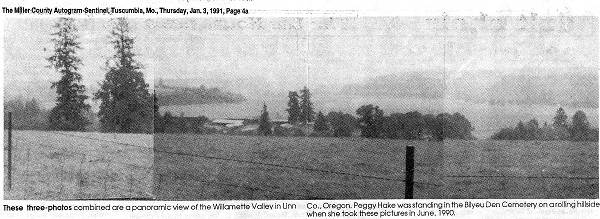
20 Bilyeu Den Cemetery
Click image for larger viewThere are about 40 other gravestones with the name Bilyeu on them. Other cemeteries in Linn County, Oregon with Miller County pioneers buried in them include: Franklin Butte Cemetery near Scio; Providence Cemetery near Scio; Miller Cemetery near Scio; Pine Grove Cemetery near Halsey; and Alford Cemetery near Harrisburg.
I will leave those pioneers in Oregon for awhile and list names of Miller County men who headed west circa 1850 heading for California with the ‘gold fever.’ Most of these fellows returned back home from California, but a few remained. It has been said that over half of Miller County’s male population traveled to the California gold fields and most returned as poor as when they left. The following are some of those who are known to have ventured to California; Madison Belshe, Boyd Miller, William Greenup, James Witten, John Stephens, Joseph Hume, Andrew Estes, Gabriel Cotton, George Claybrook, John M. Miller, John Melton, William Cotton, Thompson Howser, Elisha Shelton, George Bolton, William Shelton, Elijah Spence, Isaac Bunker, Milton Houston, John G. Simpson, Richard T. Miller Robert Reed, Joseph Thompson , Benjamin F. Cotton, Sylvester Cotton, Daniel Bliss (killed by Indians) and several Negro slaves.
I do not know how many of the Oregon Bilyeu, Kinder, McCubbin, Bryant, and Biggers families ever came back to Missouri for visits, perhaps none until later generations. In the 1890’s, a son of Creed T. Biggers came through Miller County on is way to New York. He visited the site of his birth in 1848. It was owned by the Spearman family in the 1890’s and was located west of Iberia near the Barren Fork Creek.
In our modern age, with genealogy so popular, Miller County has been visited by descendants of the Oregon Bilyeu families researching their ancestors who once lived in our county. One of my finest friendships has been with Norma Eid of Tualation, Oregon, a descendant of William and Diannah Bilyeu. She came to Miller County about five summers ago and I met her only by chance as she researched at the courthouse. She has sent me material that gives me a close kinship of spirit with her West Coast ancestors and I, in turn, helped her feel “at home” in this temporary land of her ancestors.
Over the past two years, I have also made new friendships with other Bilyeu and Kinder descendants who live in Oregon. Last summer I took a marvelous trip to the Willamette valley and visited the land where my great great great grandparents lived and died. They were Peter and Jane (Coker) Bilyeu who married in Overton County Tennessee in 1821; moved to Miller County in the mid 1830’s; he moved to Oregon in 1850; she followed him there about 1875; and both are buried in Bileu Den Cemetery in Linn County. On a cold, rain day in early June of 1990, I drove to the Bilyeu Den Country of Linn County, Oregon and searched for the graves of my ancestors. While Bonnie, my sister in law, held an umbrella over my head, we trudged through the wet grass of Bilyeu Den Cemetery and I took photographs of as many graves as I could find. It was not too easy hobbling along with gout in my right foot, but we accomplished what I had driven 2000 miles to do…I found the final resting place of my ancestors. You would have to be a lover of family history and genealogy to understand my joy!
Remember, as you live out your comfortable 20th century life, those who came before us made many sacrifices and overcame almost insurmountable odds so that we can benefit by the hardships and labors of our ancestors. We often forget and overlook our heritage, but we should always take pride in it and try to preserve it for those generations yet to come. Our forefathers carved out a new country from the Tidewater marshes of Virginia to the timbered forests of Oregon and California and left a portion of that heritage in Miller County as they stopped off here temporarily; just long enough to be a part of our 154 year history.
Thus ends this sojourn through the long and complicated history of the Bilyeu family which gave Miller County many outstanding citizens one of whom was Eula Bilyeu Fischer, whom I was delighted to present this week as one of our county’s most beloved and respected teachers.
This coming Saturday, July 10, I invite all who like home made ice cream to come to our annual ice cream social at the museum. We will be serving ice cream and other desserts between 11:00 a.m. and 2:00 p.m. Carl McDonald has been in charge of making the ice cream for many years for this event using his special recipe which everyone agrees is quite delicious. Musical entertainment will be provided by the Joe Jeffries group which includes some of the area’s most accomplished blue grass style musicians.
That’s all for this week.
 Joe Pryor
Previous article links are in a dropdown menu at the top of all of the pages.
|

